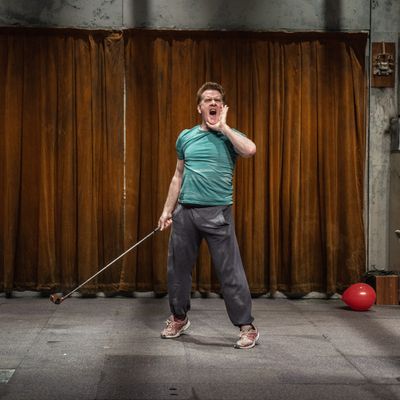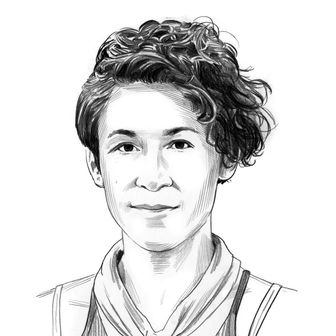
It’s scarier when Godot does show up.
Enda Walsh, the Irish playwright and director whose claustrophobic, purgatorial worlds and fascination with the disintegration of language have long marked him as a direct descendent of his countryman Samuel Beckett, has returned to St. Ann’s Warehouse. Last year the theater presented his play Arlington. Now he’s back with another dystopian fable named for a cryptic locale. This one: Ballyturk. The plays have much in common — they’re both investigations of the imagination in confinement, both verbal and physical endurance tests for actors, both amalgams of Walsh’s ear for a kind of banal vernacular patter and his taste for Orwellian scenarios. But despite having been written first (it premiered in the U.K. in 2014), Ballyturk exceeds its sibling in emotional heft and formal depth. A colder play, Arlington was interesting to contemplate in retrospect, but Ballyturk is thrilling in the moment. It’s a wild, devastating cry from a playwright who’s both celebrating the small miracle of humankind’s creative impulse and interrogating its ultimate usefulness.
So, what is Ballyturk — the place and the play? It’s a dull, provincial town, with a sleepy main drag and a dingy corner shop, with inhabitants who gossip and play bingo and eat too many Hobnobs and drink too much lager and look with suspicion on something as innocuous as a yellow sweater (“Browns and blacks are more of what you expect ’round here”). It also doesn’t exist. Town, streets, shops, citizens: all are an elaborate ongoing yarn spun by two nameless men — 1 and 2, the show’s program calls them — trapped in a grubby, windowless room where they lead lives of absurd repetition and not-so-quiet desperation. In other words, it’s another bleakly farcical little planet in the Enda-verse.
Walsh is a playwright with an unshakable, or as yet unshaken, preoccupation. He’s obsessed with stories of Limbo, of human beings in boxes, restrained and waiting, going through the rituals of life and language even as they start to forget exactly how those things worked beyond their prison walls. “Do bunnies definitely have legs, by the way?” asks 1 pensively. “We decided on five,” replies 2. Walsh is interested in what happens when you put an agonizing amount of space between the signifier and the signified: If you haven’t seen a bunny in eons, does the word “bunny” mean anything anymore? If every day is the same, what happens to concepts of time? (“What do you mean by ‘weekly’?” says 1 in innocent bewilderment, later in the play.) As 1 and 2 forget words, they retain only fuzzy half-images of anything outside their room, and so they start from scratch, telling stories to reconstitute a fast-fading reality.
Either by choice or compulsion, Walsh’s characters tend to be raconteurs. He’s both knowingly participating in the Irish storytelling tradition and creating worlds in which all there is to do is talk. As Ballyturk begins, the lights dim to a low rumble (the play’s excellent, menacing soundscape was created by composer Teho Teardo and sound designer Helen Atkinson), and then we see a figure isolated in the stark glare of a spotlight, telling a story. This is 1, the spectacular, tightly coiled Tadhg Murphy. He’s a stringy, youngish fellow in sweatpants, with stooped shoulders and an unwashed ponytail hidden under an awkward red hurling helmet. He holds a knife. He rails at the sky, squinting into the spotlight and competing with the drone. He’s in the middle of some kind of epic performance, embodying the tale of a man called Larry Aspen, who it seems has attempted to set fire to the house of the woman he fancies. “Marnie Reynolds would be waking up to her burnt kitchen,” 1 declaims operatically, “She’d smell the smoke from beneath her new perfume and hear the embers and she’d know that it was him!”
But 1’s theatrics end in an absurd anticlimax. At the height of his screams — which imply the impending suicide of this jealous arsonist — the drone cuts out, the lights return, and we see the full space: a large, shabby room without windows or doors, in which 1 now looks small and foolish. As if to humiliate him further, another man, older, dusty with talcum powder and wearing nothing but underwear, stands watching him, unceremoniously eating a bag of crisps. This is 2 (Mikel Murfi in a schlubby-clown performance that’s frantically funny and moving by turns). “Nothing,” 1 laments to 2 bitterly, sending echoes of Vladimir and Estragon through the theater. Whatever 1 was hoping to achieve with the tale of Larry Aspen, it didn’t happen. Once again, Godot hasn’t come.
The first twist in Ballyturk is that such a figure, Walsh’s homage to Beckett’s famously absent character, does eventually arrive. The box in which 1 and 2 reside literally cracks open, revealing the vast, dark reaches of the Outside World and allowing the entrance of 3 — a refined woman, soft-spoken and severe, with long white hair and an aura just as omniscient and destabilizing as you’d expect from an enigmatic near-deity. Is 3 responsible for 1 and 2’s imprisonment? Is she some sort of government agent or voyeur or scientist studying these two lab rats? Is she Death incarnate? Walsh is bravely and effectively ambivalent. With the arrival of 3, as indeed with the establishment of Ballyturk’s whole premise, he avoids exposition without falling into the kind of vagueness that loses our attention. Myriad answers, myriad meanings, buzz about this dilapidated purgatory like the fly that transfixes 1 early in the play, baffling him, reminding him of something and somewhere else, if only he could remember the words for it.
But before we meet God, or the scientist, or the Grim Reaper, or just the one who’s been watching, we’ve got to learn the routine of the ones being watched. Ballyturk begins by introducing us to the monotonous cycle of 1 and 2’s existence — first in a feverishly jaunty montage set to ABC’s “The Look of Love” (throughout the play, the pair’s repetition of bits and pieces from this ritual is the only semi-solid way to sense the passing of time).
Every day, they wake up (in the rickety Murphy bed), shower (under the trickling tap in the corner), dress (in the scruffy, ill-fitting hand-me-downs that spill from a variety of ugly prefab cabinets), eat (packets of crisps, mini-boxes of cereal), exercise (a jump rope, an old stationary bike), bop around frenetically to old 45s (Walsh loves wacky, sinister dance sequences), and, most crucially, they pretend. The walls of their room are covered in 1’s drawings. These childlike scribbled faces, streets, and landmarks are Ballyturk. At intervals, both 1 and 2 will choose characters from among the penciled headshots (they know the residents of the town by heart; after all, they created them) and launch into desperate storytelling mode. As they spin the humdrum lives of these imaginary figures — Larry Aspen, Joyce Drench, Cody Finnington — into grandiose, often violent dramas, the lights change, music swells, the room shakes, and for a few fleeting seconds it seems as if their performances might bring release. After all, between their forays into Ballyturk, 1 and 2 can hear voices through the walls. Surely someone knows they’re in here. Surely someone will hear them, will let them out.
Of course, when 3 arrives, bringing with her the possibility of freedom, it’s a bitter bargain. In a play full of stunning monologues, the superb Olwen Fouéré, weirdly ageless with her fall of white hair and her dancer’s grace, has one of the most breathtaking. It’s 3’s aria, her chance to perform — though without any of the flailing uncertainty of 1 and 2’s set pieces — and in it she provides Ballyturk’s gut-wrenching volta. “To remain upright and to be able to carry on searching,” she argues, murmuring into a hanging microphone, is a kind of mundane marvel. “How unremarkable and how faintly unique to wake and walk in this way … To stand there in the magnificence of this world with all these animals and plants and trees too many to ever imagine clearly … In a life that is so chaotically structured by nature” — it’s a miracle that requires a sacrifice. The edges of existence provide its purpose, declares 3: “For this is the order that all life demands — it needs a death.”
So 3 has a terrible proposition for 1 and 2: She can offer one of them the chance at escape, the fleeting experience life outside the box, but real freedom means having to face real death. Her arrival shatters the world of these two hapless, histrionic clowns — especially 1. Murphy, weeping with frustrated rage, speaks straight from the heart of Walsh’s own suffering when he cries out, “How can I talk about Ballyturk knowing that it’s only ever inside this breaking body and nowhere else? There’s no freedom to it — it’s filling a room with words, not real life … so how? How?”
The act of storytelling, our human ability to create worlds within words, both captivates and terrifies Walsh. It’s a life force, but it’s not life. Inside the room — the box, the theater — there might be high drama, epic fantasy, awful tragedy, but it’s all just words, words, words. Inside the theater hearts might break, but outside they might, and will, stop. Like Beckett, Walsh turns theatrical examinations of stuckness into exegeses on the art of playmaking. Theater is uniquely good at talking about, eviscerating, celebrating itself — and in Ballyturk you can sense Walsh’s fear that perhaps, in the face of real life’s chaos, that’s all it’s good for.
Ballyturk is at St. Ann’s Warehouse through January 28.


